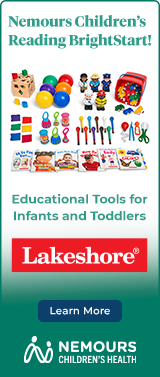Every day is a fun day with this story of a little dog, his friends, and their action-packed week. Your child will enjoy the simple colorful pictures and the rhythmic verses – each contains a day of the week and an action word that reflect the picture.
Before, During and After Reading
Oral Language
Look through the pictures in the book and set the stage for the story. Gather items similar to the ones in the book (stuffed toy dogs and cat, your child’s favorite napping blanket, daddy’s necktie, etc.) to bring the story to life and engage your child in the action.
Help him practice following multi-step directions by placing the book on a low shelf or table and ask him to get the book and bring it to you. Together, find the front cover and talk about what he sees. Sweep your finger under the words as you read the title, author and illustrator. Ask him what he thinks the story might be about. Help him with his answers if he needs it, and acknowledge any attempts he has makes. Bring out a toy dog for him to hold as you begin the story. As you encourage conversation and he answers your questions, remember to repeat what he has said, adding words to his comments.
Oral Language
Introduce new words and encourage your child to participate in the story. Use a dramatic voice to read the words and set the mood. For example, in a very quiet voice you might say:
Tuesday snooze-day. Snooze means to take a nap, can you say that word with me? Snooze. Here is your favorite blanket. Can you show me how you and your dog can take a snooze? Night, night Colton and doggy, have a nice snooze!
Phonological Awareness
Use the rhythm of the text to clap the syllables in the words or add other motions to emphasize the word parts.
You might say:
Listen, I can say the words slowly and look, I can clap my hands too. Fri [clap] day [clap] tie [clap] day [clap].
Can you do and say that with me? Fri…day…tie…day. Hooray! Clap your hands enthusiastically.
This time we can stomp our feet. Sa…..…tur…..…day! Splat……ter….…day. Try it with me!
Sa…tur…day…splat…ter…day. Hooray! Stomp your feet fast like this. Stomp your feet like you’re running in place.
Beginning Writing
Talk about the days of the week and what activities you do together. You might even look at a calendar to see an upcoming event, a birthday party, a holiday or even a trip to the grocery store. Choose one to talk about and offer paper and crayons for him to draw and express his ideas. The end result may just look like marks on the page, but if you encourage him to talk about it or write the words he says, you are connecting the printed word to spoken language and showing him that you value his effort and ideas. Encourage him to show his picture off to others in the family as well!
Letter Knowledge
Spark his interest in the alphabet by engaging him in a fun game that relates back to the story. Use the first letter of a day of the week to play an action game that exposes him to letter names, letter sounds and letter shapes. On a sheet of paper, write a large uppercase letter M, T, or S and place on the floor. Encourage your child to find a letter and bring it back to you. Talk about the letter name and letter sound and invite him to trace the shape with his finger. Look for the day of the week in the book with the same beginning letter.
You might say:
Look at the letter cards on the floor. Can you go get one and bring it to me?
You found the letter M. Can you trace it with your finger like this? Monday begins with /m/ /m/ M. Monday, run-day. Can you show me how your run? Can you say /m/ /m/ M? /mmm/ Marvelous!!
This is the letter T. Can you trace it with your finger? Tuesday begins with /t//t/T.
Tuesday, snooze-day. Can you show me how you snooze? Can you say /t/ /t/ T. /t/ /t/ Terrific!
This is the letter S. Can you trace it with 2 fingers? Sunday begins with /s//s/S.
Sunday, bun-day. Show me how you eat your bun. Can you say /s/ /s/ S. /sss/Super!
Use theme or characters of this story to adapt and enjoy the following At-Home Activities for kids 24 to 35 Months:
Beginning Writing: Pillow Tracing. Using the toy animals encourage your child to trace lines, circles or curves on the animals back or tummy.
Letter Knowledge: My Favorite Toy – The Box! Create a dog house with an empty cardboard box, write the words dog house or put your child’s name on it. Let him have fun pretending to be a dog or having fun with his toy dog friends.
Oral Language: Let’s Go For a Drive! Choose a day of the week that you have an outing. Pretend play to drive to that outing describing what you see and what you will do when you get there.
Additional Books that mention days of the week:
Explore more recommended children's books for two-year-olds, or find an at-home activity to help build important pre-reading skills.








